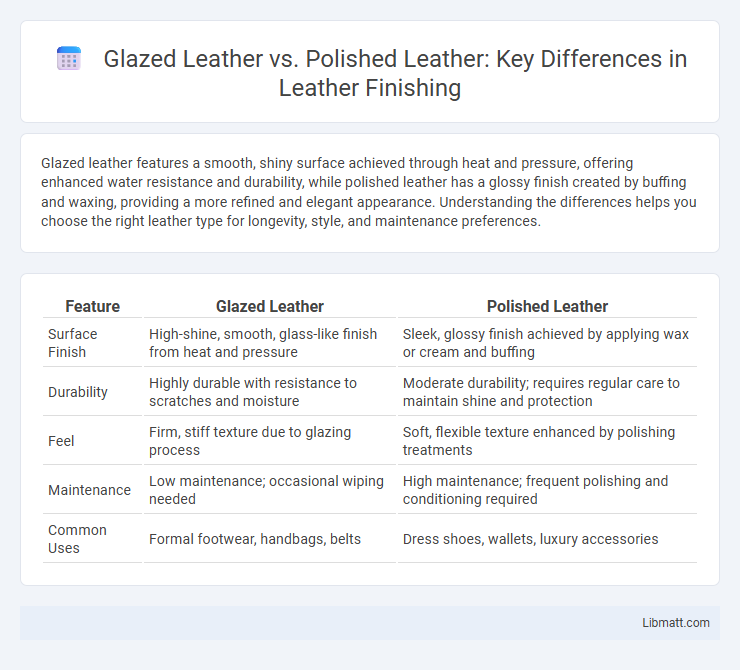Glazed leather features a smooth, shiny surface achieved through heat and pressure, offering enhanced water resistance and durability, while polished leather has a glossy finish created by buffing and waxing, providing a more refined and elegant appearance. Understanding the differences helps you choose the right leather type for longevity, style, and maintenance preferences.
Table of Comparison
| Feature | Glazed Leather | Polished Leather |
|---|---|---|
| Surface Finish | High-shine, smooth, glass-like finish from heat and pressure | Sleek, glossy finish achieved by applying wax or cream and buffing |
| Durability | Highly durable with resistance to scratches and moisture | Moderate durability; requires regular care to maintain shine and protection |
| Feel | Firm, stiff texture due to glazing process | Soft, flexible texture enhanced by polishing treatments |
| Maintenance | Low maintenance; occasional wiping needed | High maintenance; frequent polishing and conditioning required |
| Common Uses | Formal footwear, handbags, belts | Dress shoes, wallets, luxury accessories |
Introduction to Glazed and Polished Leather
Glazed leather features a glossy, smooth surface achieved through heat and pressure, enhancing its durability and resistance to water. Polished leather, often finished with a fine buffing and waxing process, offers a high shine that highlights the natural grain and adds sophistication to footwear and accessories. Understanding these differences helps you choose the right leather type for style and maintenance preferences.
What is Glazed Leather?
Glazed leather is a type of leather finish achieved by applying heat and pressure to create a smooth, shiny surface without additional coatings. This process enhances the natural grain while providing durability and a sleek appearance compared to polished leather, which typically involves buffing and applying waxes or lacquers. Understanding the unique characteristics of glazed leather helps you choose a material that offers elegance and resilience for footwear or accessories.
What is Polished Leather?
Polished leather is a type of leather treated with wax or other finishing agents to create a smooth, shiny surface that enhances durability and water resistance. This finishing process involves buffing the leather to achieve a high-gloss appearance, often used in dress shoes and luxury accessories. Unlike glazed leather, which is heated and pressed to produce shine, polished leather relies on the application of specific substances for its characteristic luster.
Key Differences Between Glazed and Polished Leather
Glazed leather features a high-shine, glass-like finish achieved through intense heat and pressure, enhancing its smoothness and water resistance, whereas polished leather is buffed to a soft, subtle sheen that highlights its natural grain and offers a more matte appearance. Glazed leather tends to be more rigid and less breathable due to its sealed surface, while polished leather remains more flexible and develops a rich patina over time. Care for glazed leather involves avoiding scratches that easily show on its slick surface, whereas polished leather requires regular conditioning to maintain its softness and sheen.
Appearance and Finish Comparison
Glazed leather features a glossy, smooth surface achieved through a high-gloss finish that enhances color depth and provides a reflective sheen ideal for dress shoes and accessories. Polished leather, often referred to as mirror or patent leather, has an even shinier, wet-look surface created by applying a resin or plastic coating that offers enhanced durability and water resistance. Both finishes emphasize sleek aesthetics, but glazed leather maintains natural leather texture beneath the gloss, while polished leather presents a uniform, flawless appearance.
Durability and Maintenance
Glazed leather offers a protective resin layer that enhances durability by resisting water, stains, and scratches, making it easier to maintain with simple wiping. Polished leather, treated with a smooth, glossy finish, provides moderate protection but requires regular conditioning and careful cleaning to prevent cracks and dullness. Both types benefit from proper storage, but glazed leather generally demands less frequent upkeep due to its tougher surface resilience.
Common Uses in Fashion and Accessories
Glazed leather features a high-shine finish achieved through heat and pressure, making it ideal for formal shoes, handbags, and belts that demand a sleek, polished look. Polished leather undergoes buffing and waxing to create a smooth surface with a subtle sheen, often used in dress shoes, wallets, and watch straps offering durability and elegance. Your choice between glazed and polished leather depends on whether you prefer a bold, reflective shine or a more understated, sophisticated appearance in fashion accessories.
Pros and Cons of Glazed Leather
Glazed leather offers a sleek, shiny finish that enhances durability and resists water and stains, making it ideal for formal footwear and accessories. However, it can be prone to cracking over time if not maintained properly and lacks the breathability found in untreated leather. The high-gloss surface is less flexible, which may reduce comfort during extended wear compared to polished leather.
Pros and Cons of Polished Leather
Polished leather offers a high-gloss finish that enhances durability and resists water and stains, making it ideal for formal footwear and accessories. Its smooth surface requires regular maintenance to prevent cracking and preserve its shine, which can be challenging for some users. While polished leather provides a sleek, elegant appearance, it may lack the natural breathability and flexibility found in glazed leather.
Which Leather Should You Choose?
Glazed leather offers a smooth, glossy finish that enhances durability and resists water, making it ideal for everyday use and formal occasions. Polished leather, on the other hand, provides a high-shine, mirror-like appearance achieved through buffing and waxing, perfect for dress shoes and luxury accessories requiring a refined look. Choosing between glazed and polished leather depends on your preference for maintenance level, durability, and the specific style statement you want to convey.
Glazed leather vs polished leather Infographic

 libmatt.com
libmatt.com